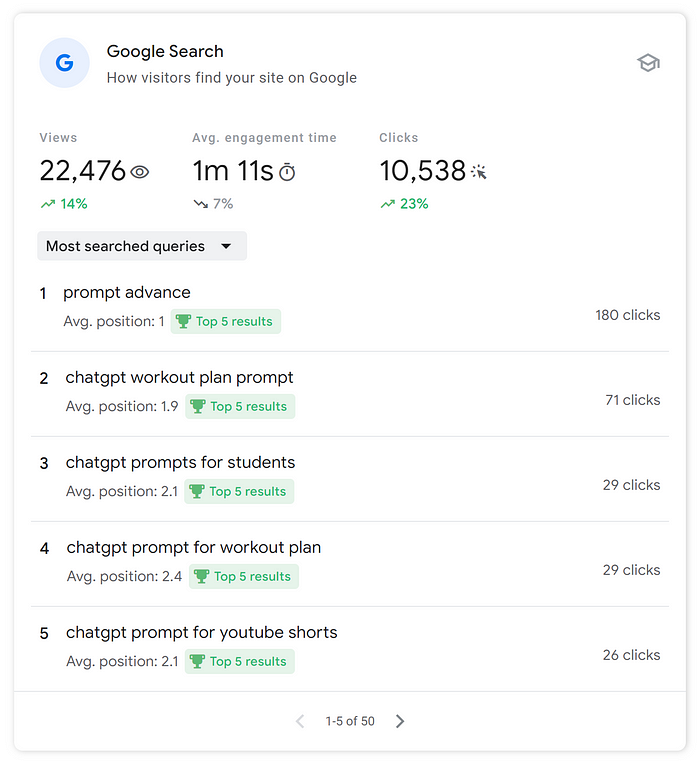I launched a new business a couple of months ago. After research, planning, and setting up the website, the next challenge was getting traffic.
With my decent knowledge of SEO, the choice was obvious: SEO blog posts for organic traffic.
But here’s the thing. I didn’t want to spend hours writing content in my basement. Nor did I want to hire cheap writers from 3rd world countries.
I decided to go with the most cost-effective solution: AI.
For the past eight months, AI has been running my SEO blog. It never called in sick, never missed a deadline, it’s just sitting there quietly, ready for its next task.

As you can see, the site is on its way to 50 thousand visitors, with 10 thousand monthly clicks and steady growth every week.
Not only is it growing, it’s ranking at the top of search results for multiple keywords.

BTW: If you need a similar AI SEO strategy, you can book a free call with me.
Seeing these results is incredibly rewarding. And I’m also confident the site will continue to grow. But this wasn’t always the case.
When I started, I was scared as a cat at a dog convention. Do you know why?
There are many problems with AI-generated content for SEO:
- AI writing can be easily detected.
- AI content doesn’t provide any new perspective.
- Google can penalize your site for using AI content.
I had to find solutions for every one of these problems. And that’s what I’m sharing today. I’m sharing how I overcame each obstacle, solved every issue, and grew my site to where it is now.
I’ll provide examples, pages, prompts, workflows, and tips I’ve learned along the way. So if you’re ready to hear my story, let’s dive in.
But first, let me quickly introduce the website to give you more context.
What’s My SEO Site About
The site is called Prompt Advance, and it’s about ChatGPT prompts. The concept is simple: have a huge database of ChatGPT prompts for various needs.
When someone searches for “ChatGPT prompts to help with ADHD”, they’ll see my site at the top, visit it, and find the prompts they need.

Sounds simple enough, but there’s a challenge. People search for all kinds of prompts, and it’s impossible to cover all of them by myself. That’s why I decided to hire AI as my writer.
How I’m Using AI to Grow IT
As I already mentioned, there were three problems I had to solve. And if I couldn’t crack all of them, my site wouldn’t grow.
Problem #1: AI content doesn’t provide any new perspective
AI can’t come up with anything new. This is just a fact, and there’s nothing we can do about it. Sure, AI can regurgitate multiple sources and spit out content in a new way, but it’s just that — a mix of existing information.
It’s not something new.

So how did I solve this problem?
I simply didn’t. I accepted that to provide the best quality content, I had to help where necessary. Instead of letting AI do everything, I’d step in where it’s needed most.
BTW: This is the part I wouldn’t let AI do and it’s the part I’m still doing manually.
For every blog post I wrote, I did the following:
- Researched the topic and the associated problems.
- Thought about how ChatGPT could solve those problems.
- Fed all that information back to AI.
To demonstrate this on actual example, let’s say I want a blog post targeting the keyword “ChatGPT prompts for musicians.”
- I research what musicians do in their day-to-day lives.
- I find areas where ChatGPT could help them.
- I write prompts for those areas.
If I do this, I’m solving problem #1 because I’m feeding AI my findings and my perspective. If you’ve ever heard the phrase “good data in, good data out,” this is exactly that.
Problem #2: AI writing can be easily detected
It’s often said that AI content can be easily detected, and if it is, you’re pretty much doomed. I saw many tools claiming to check if text is AI-generated, and I assumed Google would use something similar.
But Mama Mia was I wrong! Google doesn’t care.
They don’t care if you write the content, if AI writes it, even if your cat writes it. All they care about is that you provide high-quality content that your audience enjoys reading.
If you don’t believe me, here’s what they say:
Our focus on the quality of content, rather than how content is produced, is a useful guide that has helped us deliver reliable, high quality results to users for years. (source: Google)
It looks like problem #2 is already solved, but that’s not quite true.
I still need a way to prompt ChatGPT for blog posts that meet my standards. I want my blog posts to be written, structured, and presented in a particular way.
I tried various prompting techniques, but the results weren’t good. I played around, watched some tutorials, and that’s when I learned about AI agents.
I don’t want to get too technical, but here’s the basic gist of AI agents:
- You don’t ask AI to write a blog post in one go.
- You split the task into steps.
- You let AI agents handle each step on their own.
Sounds good in theory, but what does it look like in practice? Let my inner Picasso explain.










